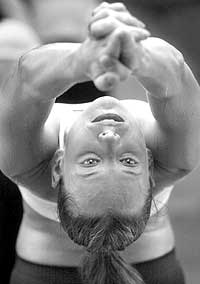
|
Hot
& Sweaty: MINNEAPOLIS — Bob Davis, host of KSTP radio’s late-night show, had no idea what to expect when he began taking Bikram yoga last fall. Students do the same 26 postures every class, in a room kept at 105 degrees Fahrenheit. Classes are 90 minutes long. Davis took to it immediately, despite the environmental challenges. “It was hard,” says Davis of Minneapolis. “It’s just hard to get through it and not puke. But it gets easier.”
Apparently so. After Davis’ gym closed, he started taking two yoga classes a day. Yoga in a sweatbox is making its way across the country. Bikram is a form of hatha yoga, which focuses on posture, movement and breath. It takes its name from its creator, Bikram Choudhury, a former yoga champion from India. The moist heat in the classroom’s environment encourages deeper stretching and detoxification — i.e. sweating. “It is a great class for anyone who doesn’t have real specific health concerns,” says Mara Carrico, yoga spokeswoman for the American Council on Exercise. “If they’re out of shape and a couch potato, it’s going to be a killer.” Yoga is an ancient tradition, but with the popularity of mind-body medicine, it has become an area of scientific study. In one small study last year, researchers at the University of California at Davis found that regular hatha yoga practice can improve physical fitness. They recruited 10 healthy, untrained people who attended at least two yoga classes a week for eight weeks. Each session consisted of 10 minutes of breathing exercises, 15 minutes of warmups, 50 minutes of yoga postures and 10 minutes of relaxation in a “corpse” pose. Researchers found that the subjects’ muscular strength, muscular endurance and oxygen uptake improved. A Bikram yoga class consists of 26 postures sandwiched between two breathing exercises. The poses are performed in the same order every time — twice. Standing and balancing poses take up the first hour of class. The last half-hour consists of poses done on the floor. “Most of my students are type A who think they can go in there and do everything,” says Martha Williams, who runs a Bikram studio in Minneapolis. “It The class isn’t for everyone. Before signing up, students should get their doctors’ blessings, says Mary Margaret Anderson, who runs a Bikram studio in Plymouth, Minn. She does not recommend the class for pregnant women, people with heart conditions or young children. People with certain back conditions and/or joint replacements also should avoid or modify certain poses that could aggravate their conditions. “Any time there are set postures, people need to remember not all bodies fit them,” says Carolyn Hedin, owner of Bluewater Yoga Studio in Red Wing, Minn. In a Bikram yoga class, students learn to focus on the instructions, not the instructor. The teacher circulates throughout the room giving cues. “It’s a moving meditation,” says Scott Potter of St. Paul, Minn., who recently completed 80 classes in 80 days. “I have never gotten bored. You learn something new each time about how your body works.” Williams and Anderson, who are sisters, went to California for nine weeks of intensive “yoga boot camp” with Choudhury, who requires the training to open a school in his name. Anderson opened her studio in August. Williams taught at the YMCA, Club Shelard and Northwest Athletic Club before opening her studio in October. After Williams left Northwest, the chain introduced a new program, Synergy Yoga, which consists of 37 postures done in rooms kept from 85 to 95 degrees. Synergy includes other postures and breathing techniques not done in a Bikram class. “Synergy is very heart-centered, spiritual, physical — a practice with intention,” says Kari Olson, group fitness coordinator at Northwest’s club in the St. Louis Park section of Minneapolis. “Focusing on the spiritual eye — the third eye—- deep within.” Students leave competition at the door. Or at least they try to. “There’s always going to be someone who can do it better,” Davis says. “It’s not a race. It’s the only thing that combines the spiritual, physical and mental. You’re going to meet yourself in there.” |
|||
|
TCU Daily Skiff © 2002 |
||||


